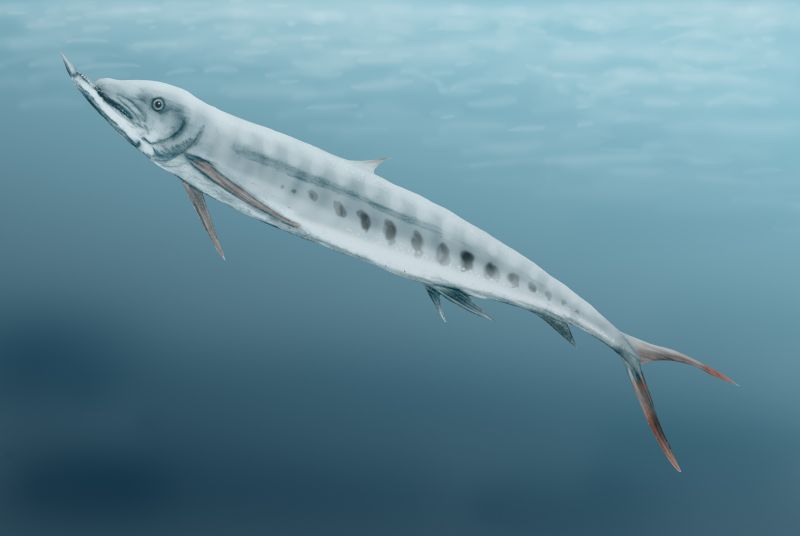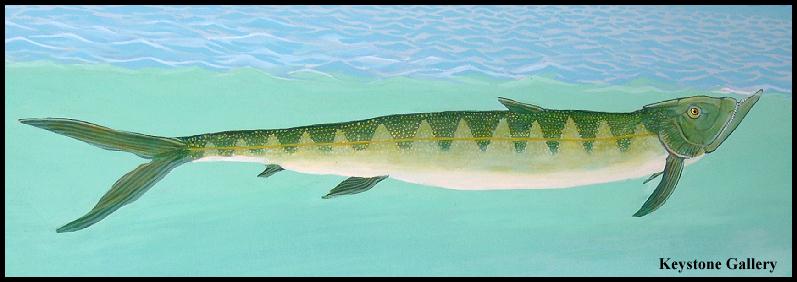[Recent Entries][Archive][Friends][User Info]
| May 30th, 2013 | |
|---|---|
| 07:45 pm [industrialterro] [Link] |
Saurodon Saurodon ("Lizard Tooth") is an extinct genus of Ichthyodectid fish from the Cretaceous. Saurodon leanus is known to occur as early as the late Coniacian through the Santonian, in the Late Cretaceous. It was a large, predatory fish, with a length of more than 2.5 m. When Lewis and Clark set out in 1804 on their westward trek to explore the Louisiana Purchase, they had no idea that they would also be crossing the expanse of an ancient ocean that once covered the middle of North America. It was early in the trip when they found the only fossil specimen that survives today from the collections made by the expedition along the Missouri River, along the western border of what is now the Harrison County, Iowa. Meriwether Lewis described the remains in a note that survives along with the specimen as "the petrified jaw bone of a fish" (below; see Spamer, et. al., 2000, for a more detailed account). The specimen was eventually presented to the American Philosophical Society where it was studied, and then mis-identified some years later by Dr. Richard Harlan (1824) as a new species of marine reptile, Saurocephalus lanciformis. He believed it to be most closely related to the marine reptiles called ichthyosaurs. Hays (1830) described a similar specimen from New Jersey but noted that it was clearly the skull of a fish, not a reptile, and declined to use Harlan's mis-leading genus name of Saurocephalus. Instead he established a new genus (Saurodon) and species (leanus). Later, Joseph Leidy (1857, p. 302) incorrectly noted that the specimen mis-identified by Harlan was a fragment of a "maxillary bone with teeth of peculiar genus of sphyrænoid (barracuda-like - see Protosphyraena) fishes from the Cretaceous formation of the Upper Missouri." The type specimen of Saurocephalus lanciformis (ANSP 5516) was also the first fossil fish and the first vertebrate to be collected, illustrated and described from the Niobrara Formation. Over the years, the number of named Saurodon / Saurocephalus 'species' grew to eleven, but the number was reduced to two by Bardack and Sprinkle (1969). Stewart (1999) re-described a third species (Prosaurodon pygmaeus) that had originally been named Saurodon pygmaeus by Loomis in 1900. According to Stewart, Prosaurodon specimens have often been mis-identified as Ichthyodectes. Saurodontinae is a sub-family of the Ichthyodectidae (Earl Manning, pers. comm., 2004) and includes three genus/species in the Western Interior Sea, of which Prosaurodon is the most primitive. All of the species were medium to large-sized (2-3 m / 5-9ft), elongate predatory fish and are relatively uncommon as fossils in the chalk. The most unusual character of these fish is the pre-dentary bone that projected forward from the lower jaw. The function of this under-slung extension of the lower jaw is unknown but it gives a different perspective to the phrase “leading with your chin.” Another characteristic of these fish their flat, blade-like teeth, set in a single row in the jaws. In Saurocephalus and Saurodon, the teeth are closely set, nearly vertical and have a “keyhole-like” notch at the base of each tooth on the inside of the jaws. In Prosaurodon, the teeth have a more rounded cross-section, are more widely set, inclined anteriorly, and do not have the basal notch found in the other two species. From Stewart’s (1999) phylogenetic analysis, it appears that Gillicus (Ichthyodectidae) is more closely related to Saurodon than to Xiphactinus. The three species apparently occur at differing times in the Western Interior Sea with little overlap. According to Stewart (1999), Saurocephalus lanciformis appears only in the uppermost chalk (Early Campanian) while Saurodon leanus is known from the lower through the middle chalk (Late Coniacian through the Santonian). Prosaurodon pygmaeus appears first about the middle of the chalk and continues upwards into the Sharon Springs Member of the Pierre Shale (Ibid.; Carpenter, 1996). Pre-Niobrara records of the Saurodontidae are unknown in Kansas. However, a much older specimen from the Cenomanian Eagle Ford Group of Texas (Stewart and Friedman, 2001) suggests that family existed for some time before the deposition of the Niobrara.
Ископаемые останки (1, 2, 3, 4):
Tags: Вымершие рыбы, Лучепёрые, Мел |





